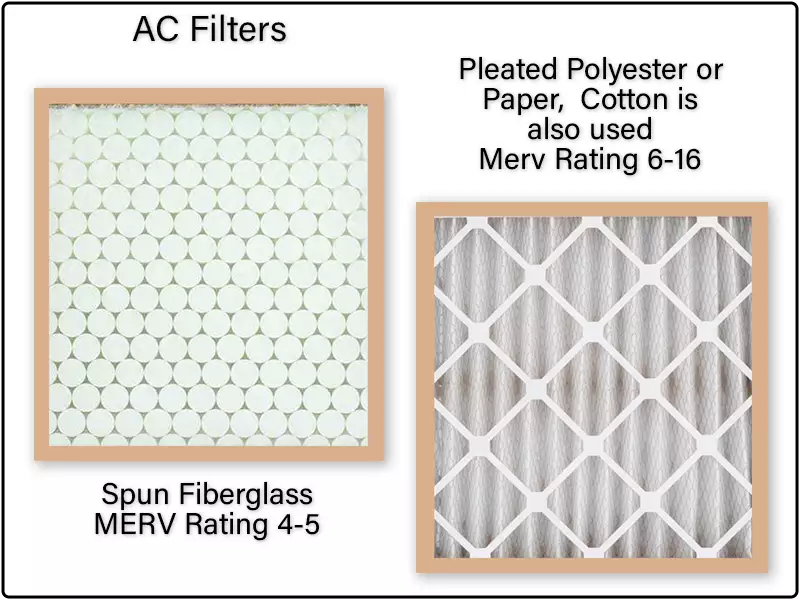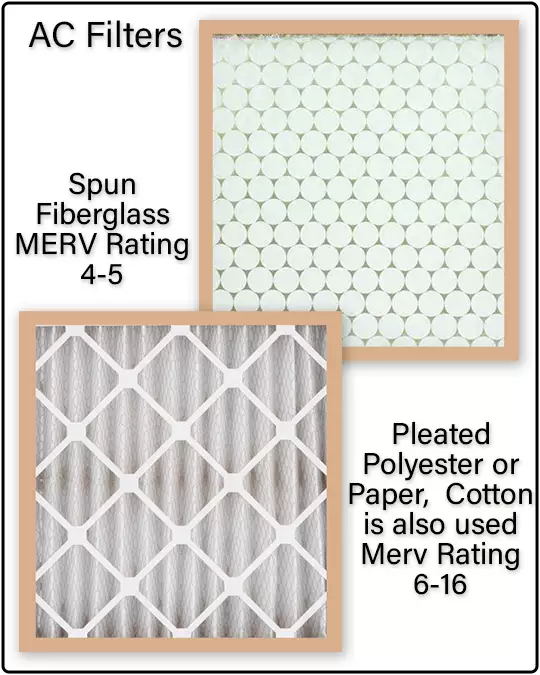

Do You need a Filter
The Problem with running your AC without a Filter or a Low MERV Rated Filter, the Dust plus many other Small Particles are Circulated through the System back into the Rooms. The Particles will eventfully get trapped in Places like the Ducting, the Evaporator Coil in the Air Handler and maybe on a Shelf or any Flat Surface.
Dust Particles build upon each other causing Odors or Restricting Air Flow. It happens Slowly over time. Properly Selected Merv Rated Air Filters do Help reduce Floating Dust and Protect your AC Unit.
Where it Comes From
Sixty Percent of Household Dust comes from Outside. Your Shoes, Clothing, Open Doors & Windows and Un-Sealed Cracks around the Doors & Windows.
What is the Dust
Inside your Home Dust comes from Dead Human Skin that settles down then attracts Dust Mites and other Micro Particles. Some say the Inside Air is mostly Dead Skin Cells.
If you have Pets the Dander gets in to the Furniture or can be brought in by Visitors that have Pets. Pet Dander is also an Attraction for Dust Mites.
Dust Mites are a Microscopic Insect that eat Dead Human Skin Cells. Dust Mites Insects don't Bite people like other Bugs but they can cause an Allergic Reaction when Inhaled by People that have Allergies to Dust.
Do Filters Help
The Central AC can help Trap the Dust, Cooling the Inside Air requires Circulation through the Filter First on way to the Evaporator where the Cooling takes Place.
Basic Acronyms and Sizes.
- A (µm) is a micrometer, one millionth of a meter called a Micron
- MERV (Minimum Efficiency Reporting Values) 1 - 20
- MPR (Microparticle Performance Rating) 3M Filtrete
The MPR Rating is only used on the Filtrete Brand of 3M Filters. 3M felt that the MERV Rating System did not go Far enough in the measuring of Microparticles getting Filtered out in the Circulation Process.
MERV & MPR Comparisons
Chart below is in part from EPA.gov Website and 3M
- MERV & MPR Rating on Left
- Particle Sizes in Microns Across the Top
- Left to Right Smallest to Largest
- * = No Info Available
| MERV/ MPR |
0.3 - 1.0 | 1.0 - 3.0 | 3.0 - 10 |
|---|---|---|---|
| MERV - 5 | * | * | 20% |
| MPR - 300 | 12% | 38% | 34% |
| MERV - 7 | * | * | 50% |
| MPR - 600 | 23% | 54% | 55% |
| MERV - 11 | 20% | 65% | 85% |
| MPR - 1000/1200 | 41%/42% | 77%/78% | 88%/88% |
| MERV - 12 | 35% | 80% | 90% |
| MPR - 1500 | 54% | 83% | 90% |
| MERV - 13 | 50% | 85% | 95% |
| MPR - 1900/2200 | 62%/69% | 87%/90% | 95%/96% |
| MERV - 14 | 75% | 90% | 95% |
| MPR - 1900/2200 | 62%/69% | 87%/90% | 95%/96% |
| MERV - 15 | 85% | 90% | 95% |
| MPR - 1900/2200 | 62%/69% | 87%/90% | 95%/96% |
| MERV - 16 | 95% | 95% | 95% |
| MPR - 1900/2200 | 62%/69% | 87%/90% | 95%/96% |
Above 17 are HEPA Ratings
High Efficiency Particulate Air (HEPA) Filters rated above MERV Rating 16 can Theoretically Trap 99.7% to 99.9% Particles, of dust, pollen, mold, bacteria, and any airborne particles with a size of 0.3 microns (µm). HEPA Filters most likely are not be used in Home AC Units, they Restricts Air Flow. Some AC Units can be Suited for the HEPA Filters Ask your Manufacture. AC Filters with a MERV Rating of 13 - 16 can be considered to have the Air Quality Level equal to a Hospital.
A MERV Rating of 1 - 2 would be of little to No Value Trapping Indoor Dust. A Spun Fiberglass Filter having a MERV Rating of 5 would have very little Air Flow Restriction and will let Particles 10 microns or Smaller Pass Through back into the Home or Collects in the Ducting.
Most AC Manufactures suggest a Filter with a MERV Rated at 13 or Less because of Air Flow Requirements. Some AC Units start to have Air Flow Restrictions at a MERV 9, and others can go to a Merv 12 so it's important to check.
Don't Believe all that's Printed
I read a Comment on an AC Website that states, "most High Efficiency HVAC Systems Recommend Merv Ratings below 5". I would Seriously not believe Experts speaking from their Position on the Couch. Look at your HVAC Manufactures Recommendations and consider your needs before Switching.
Like this Article, you can give us a Thumbs just click on the Icon. It's anonymous and we will Thank You.

“We've got to Pause and Ask Ourselves: How much Clean Air do we need”
Lee Iacocca
© Copyright 2023 YPRemodel.com. All rights Reserved. This material may not be Published, Broadcast, Rewritten or Redistributed without written Permission.
